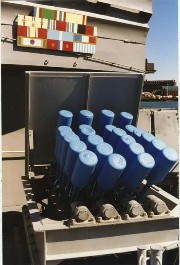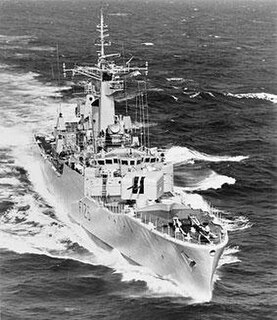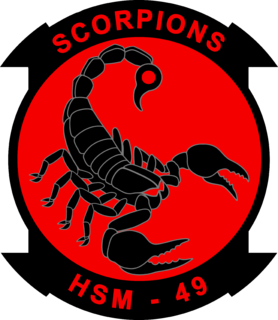Related Research Articles

Sonar is a technique that uses sound propagation to navigate, measure distances (ranging), communicate with or detect objects on or under the surface of the water, such as other vessels. Two types of technology share the name "sonar": passive sonar is essentially listening for the sound made by vessels; active sonar is emitting pulses of sounds and listening for echoes. Sonar may be used as a means of acoustic location and of measurement of the echo characteristics of "targets" in the water. Acoustic location in air was used before the introduction of radar. Sonar may also be used for robot navigation, and SODAR is used for atmospheric investigations. The term sonar is also used for the equipment used to generate and receive the sound. The acoustic frequencies used in sonar systems vary from very low (infrasonic) to extremely high (ultrasonic). The study of underwater sound is known as underwater acoustics or hydroacoustics.

The Sikorsky SH-3 Sea King is an American twin-engined anti-submarine warfare (ASW) helicopter designed and built by Sikorsky Aircraft. A landmark design, it was one of the first ASW rotorcraft to use turboshaft engines.

The Astute class is the latest class of nuclear-powered fleet submarines (SSNs) in service with the Royal Navy. The boats are being constructed by BAE Systems Submarines at Barrow-in-Furness. Seven boats will be constructed: the first of class, Astute, was launched by Camilla, Duchess of Cornwall, in 2007, commissioned in 2010, and declared fully operational in May 2014. The Astute class is the replacement for the Trafalgar-class fleet submarines in Royal Navy service.

The Westland WS-61 Sea King is a British licence-built version of the American Sikorsky S-61 helicopter of the same name, built by Westland Helicopters. The aircraft differs considerably from the American version, with Rolls-Royce Gnome engines, British-made anti-submarine warfare systems and a fully computerised flight control system. The Sea King was primarily designed for performing anti-submarine warfare (ASW) missions. A Sea King variant known as the Commando was devised by Westland to serve as a troop transport.

The AgustaWestland AW101 is a medium-lift helicopter in military and civil use. First flown in 1987, it was developed by a joint venture between Westland Helicopters in the United Kingdom and Agusta in Italy in response to national requirements for a modern naval utility helicopter. Several operators, including the armed forces of Britain, Denmark, and Portugal, use the name Merlin for their AW101 aircraft. It is manufactured at factories in Yeovil, England and Vergiate, Italy; licensed assembly work has also taken place in Japan and the United States.

The Delhi-class destroyers are guided-missile destroyers of the Indian Navy. Three ships of this class are in active service. The Delhi-class vessels were the largest vessels to be built in India at the time of their commissioning. The ships were built by Mazagon Dock Limited (MDL) at a cost of ₹750 crore each.

The Sikorsky CH-124 Sea King is a twin-engined anti-submarine warfare (ASW) helicopter designed for shipboard use by Canadian naval forces, based on the US Navy's SH-3. It served with the Royal Canadian Navy (RCN) and Canadian Armed Forces from 1963 to 2018.

An anti-submarine weapon (ASW) is any one of a number of devices that are intended to act against a submarine and its crew, to destroy (sink) the vessel or reduce its capability as a weapon of war. In its simplest sense, an anti-submarine weapon is usually a projectile, missile or bomb that is optimized to destroy submarines.
Thales Underwater Systems (TUS), formerly known as Thomson Marconi Sonar, is an international defence manufacturer specialising in sonar systems for submarines, surface warships, and aircraft as well as communications masts and systems for submarines. TUS is a subsidiary of Thales Naval, part of the Thales Group, and has sites in the United Kingdom, France, and Australia. TUS is made up of three subsidiary companies: TUS Ltd. in the UK, TUS SAS in France and TUS Pty. in Australia, but it operates as a single company with headquarters in southern France. TUS had annual sales of €400 million in 2006 and employed around 2,100 people.

Anti-submarine warfare is a branch of underwater warfare that uses surface warships, aircraft, submarines, or other platforms, to find, track, and deter, damage, and/or destroy enemy submarines. Such operations are typically carried out to protect friendly shipping and coastal facilities from submarine attacks and to overcome blockades.

The Rothesay class, or Type 12M frigates were a class of frigates serving with the Royal Navy, South African Navy and the Royal New Zealand Navy.

The Hatsuyuki-class destroyer is a class of destroyer, serving with the Japan Maritime Self-Defense Force (JMSDF). It was the first class of first generation of general-purpose destroyers of the JMSDF.

The Jacob van Heemskerck-class frigate was a class of frigates of the Royal Netherlands Navy. They were designed to be an air defence version of the Kortenaer class. The helicopter was replaced by a Standard medium range surface-to-air missile (SAM) system and associated radars. Two ships were built for the Royal Netherlands Navy. In 2005 they were sold to the Chilean Navy.

The Akizuki class of destroyers of the Japan Maritime Self-Defense Force is intended to escort the Hyūga-class and Izumo-class helicopter destroyers, and safeguard the other Aegis-capable warships such as the Kongō class and Atago class. The destroyer provides defense against surface, airborne and undersea threats. The class was initially designated as "19DD", referring to a date on the Japanese calendar, specifically the 19th fiscal year of the Heisei period (2007).
Geophysical MASINT is a branch of Measurement and Signature Intelligence (MASINT) that involves phenomena transmitted through the earth and manmade structures including emitted or reflected sounds, pressure waves, vibrations, and magnetic field or ionosphere disturbances.

Naval tactics play a crucial role in modern battles and wars. The presence of land, changing water depths, weather, detection and electronic warfare, the speed at which actual combat occurs and other factors — especially air power — have rendered naval tactics essential to the success of any naval force.

The AN/AQS-13 series was a helicopter dipping sonar system for the United States Navy. These systems were deployed as the primary inner zone anti-submarine warfare (ASW) sensor on aircraft carrier based helicopters for over five decades. Companion versions with the AQS-18 designation were exported to various nations around the globe.

Helicopter Maritime Strike Squadron 49 (HSM-49) is a United States Navy Maritime Strike helicopter squadron based Naval Air Station North Island, California.
The Daegu-class frigate is a class of guided missile frigates of the Republic of Korea Navy (ROKN). The Daegu-class is based on the preceding Incheon-class frigate, and has otherwise been referred to an Incheon-class batch II, or FFG-II. Eight Daegu-class ships are planned, with the final goal of 20-22 frigates in the ROKN. The Daegu-class frigates are to be built by Daewoo Shipbuilding & Marine Engineering (DSME) and Hyundai Heavy Industries.

HNLMS Kortenaer (F807) was a frigate of the Kortenaer class. The ship was in service with the Royal Netherlands Navy from 1978 to 1997 and today serves as HS Kountouriotis with the Hellenic Navy. The frigate was initially named after Dutch naval hero Egbert Bartholomeusz Kortenaer and then after Pavlos Kountouriotis, distinguished Admiral of the Hellenic Navy, responsible for Greek naval victories in the Aegean Sea that secured the Aegean for Greece during the First Balkan War. The ship's radio call sign was "PADA".
